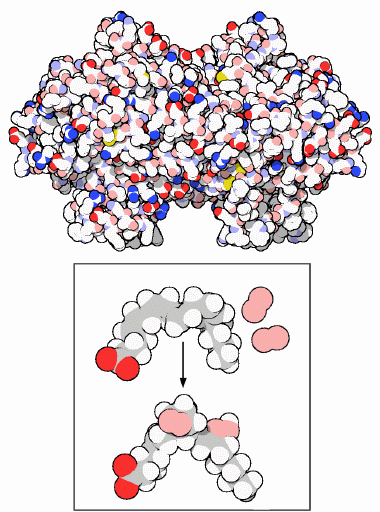|
Inhaltsübersicht | Nanomaschinen | Moleküle | Programme | Kurse | Fun | Links |
||
| > |
Cyclooxygenase

Next: A Complex Enzyme
A Wonder Drug
What is the most commonly-taken drug today? It is an effective painkiller. It reduces fever and inflammation when the body gets overzealous in its defenses against infection and damage. It slows blood clotting, reducing the chance of stroke and heart attack in susceptible individuals. And, there is growing evidence that it is an effective addition to the fight against cancer. This wonder drug, with manifold uses in medicine, is aspirin. Aspirin has been used professionally for a century, and traditionally since ancient times. A similar compound found in willow bark, salicylic acid, has a long history of use in herbal treatment. But only in the last few decades have we understood how aspirin works, and how it might be improved.
Prostaglandins
As you might expect from a drug with such diverse actions, aspirin blocks a central process in the body. Aspirin blocks the production of prostaglandins, key hormones that are used to carry local messages. Unlike most hormones, which are produced in specialized glands and then delivered throughout the body by the blood, prostaglandins are created by cells and then act only in the surrounding area before they are broken down. Prostaglandins control many of these neighborhood processes, including the constriction of muscle cells around blood vessels, aggregation of platelets during blood clotting, and constriction of the uterus during labor. Prostaglandins also deliver and strengthen pain signals and induce inflammation. These many different processes are all controlled by different prostaglandins, but all created from a common precursor molecule.
Cyclooxygenase (shown here from PDB entry 1prh) performs the first step in the creation of prostaglandins from a common fatty acid, as shown in the box. It adds two oxygen molecules to arachidonic acid, beginning a set of reactions that will ultimately create a host of unusual molecules. Aspirin blocks the binding of arachidonic acid in the cyclooxygenase active site. The normal messages are not delivered, so we don't feel the pain and don't launch an inflammation response.
COX-1 and COX-2
We actually build two different cyclooxygenases (termed COX-1 and COX-2) for different purposes. COX-1 is built in many different cells to create prostaglandins used for basic housekeeping messages throughout the body. The second enzyme is built only in special cells and is used for signaling pain and inflammation. Unfortunately, aspirin attacks both. Since COX-1 is targeted, aspirin can lead to unpleasant complications, such as stomach bleeding. Fortunately, specific compounds that block just COX-2, leaving COX-1 to perform its essential jobs, are now becoming available. These new drugs are selective pain-killers and fever reducers, without the unpleasant side-effects.
Last changed by: A.Honegger,